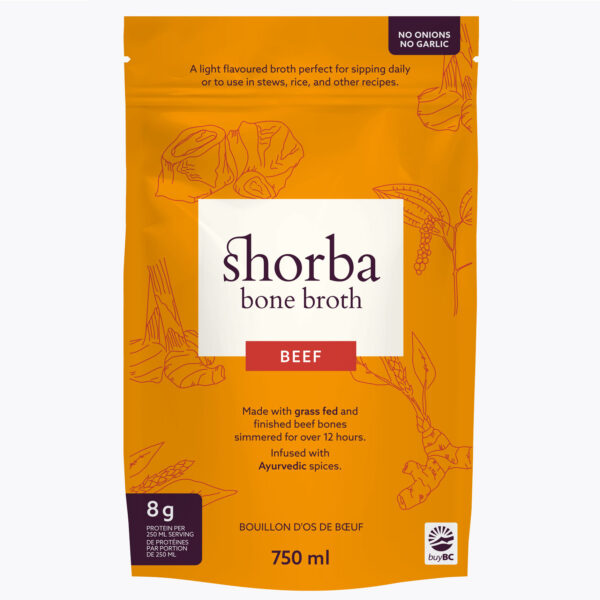Bone Broth Delivery 101: What to Expect
Bone Broth Delivery 101: What to Expect
Blog Article
The Ultimate Overview to Taking Pleasure In and making Organic Bone Broths in the house
Bone broth has obtained attention for its countless health and wellness benefits and cooking flexibility. Crafting natural bone brew in the house permits people to manage the top quality of active ingredients, guaranteeing a nutritious outcome. Recognizing the choice of bones, essential flavoring components, and appropriate food preparation methods is important. As the procedure unravels, one might wonder just how to elevate their broth beyond the essentials and include it into daily meals for improved taste and nourishment.
Understanding the Wellness Conveniences of Bone Broth
Although bone brew has been a staple in various cuisines for centuries, its health and wellness benefits have obtained considerable focus in recent years. Rich in collagen, amino acids, and minerals, bone brew is often proclaimed for its potential to sustain joint health, improve digestive tract feature, and boost skin flexibility. The gelatin stemmed from prepared bones might assist digestion and help seal the digestive tract lining, potentially easing problems like leaky intestine syndrome.Furthermore, the visibility of nutrients such as glucosamine and chondroitin might add to lowered swelling and pain relief in joints. Additionally, bone broth is moisturizing and can work as a nourishing base for soups and stews. Numerous advocates likewise declare that it increases the body immune system, many thanks to its mineral account. On the whole, the revival of rate of interest in bone broth is linked to its viewed capability to promote total health and assistance different bodily functions.
Choosing the Right Bones for Optimum Flavor and Nutrition
What elements should one think about when picking bones for brew preparation? The type of bones utilized considerably influences both flavor and nutritional value. First, it is crucial to select bones that consist of a mix of marrow bones, joint bones, and meaty bones. Marrow bones give healthy and balanced fats and rich tastes, while joint bones add collagen, improving the brew's dietary profile.Additionally, sourcing bones from pasture-raised or grass-fed animals guarantees better and more nutrients, as these animals are normally much healthier. The freshness of the bones is likewise important; choosing bones from neighborhood butchers or farmers' markets can guarantee perfect taste. Bone size matters also; larger bones launch even more jelly, causing a richer brew. Lastly, considering the sort of animal-- beef, fish, or hen-- can affect the final preference, permitting functional brew choices customized to individual preferences.
Crucial Ingredients for a Tasty Bone Brew

Quality Bone Selection
The foundation of a delicious bone broth depends on the mindful choice of high-grade bones. Sourcing organic, grass-fed or pasture-raised bones is vital, as these alternatives are most likely to be without unsafe ingredients and offer exceptional nutrients. Ranges such as hen, beef, or lamb bones each pass on distinct tastes and wellness advantages. Bone types, including marrow bones, knuckle bones, and oxtails, contribute gelatin and collagen, enhancing the broth's texture. Selecting bones with a mix of meat and connective tissue can likewise include splendor and deepness. Additionally, selecting bones with visible marrow ensures a nutrient-dense broth, elevating the general high quality. Eventually, spending time in high quality bone selection prepares for a nourishing and tasty broth.
Fragrant Taste Enhancers
Picking top quality bones establishes the stage for a rich and nourishing bone brew, however it is the enhancement of fragrant flavor boosters that genuinely elevates the meal. Ingredients such as onions, garlic, and carrots not only present sweet taste but likewise add depth to the broth. Fresh natural herbs like thyme, parsley, and bay leaves include an aromatic note, while flavors such as black peppercorns and cloves introduce warmth and intricacy. In addition, incorporating a splash of apple cider vinegar can help extract minerals from the bones, improving the broth. These flavor enhancers develop a harmonious mix, transforming a simple brew into a tasty structure for stews, sauces, or soups, making it a versatile part in any cooking repertoire.
Step-by-Step Guide to Making Bone Broth in your home
Developing bone broth in the house can be a satisfying culinary venture that improves both taste and nutrition in different meals. To start, one need to pick top quality bones, ideally from organic or grass-fed resources. Toasting the bones at 400 ° F for about half an hour can increase the taste. Next off, transfer the baked bones to a huge pot or sluggish cooker and cover them with cool water. Including a sprinkle of vinegar assists remove minerals from the bones.Include fragrant veggies like onions, carrots, and celery for included deepness, together with natural herbs and flavors as preferred. Bring the mix to a boil, then reduce to a simmer. It is vital to allow the brew simmer for a minimum of 12 hours, though longer is preferable for maximum richness. Ultimately, strain the broth through a fine-mesh filter and shop it in airtight containers, ready to boost dishes with its nourishing significance.

Tips for Improving Your Bone Brew Simmer
While simmering bone brew, maintaining the appropriate temperature and timing is important for achieving a abundant and delicious outcome. A gentle simmer, preferably in between 190 ° F and 210 ° F, assists extract maximum nutrients and flavors without steaming, which can make the broth cloudy. It is suggested to monitor the pot carefully, adjusting the warm as needed to preserve this simmer.Timing is also essential; a longer simmer, generally varying from 12 to two days, enables much deeper taste extraction and collagen release. For poultry bones, a 12 to 24-hour simmer is adequate, while beef bones profit from longer cooking times.Additionally, skimming off any kind of foam or impurities that climb to the surface throughout the very first few hours can boost the broth's quality and preference. Ultimately, making sure the pot is covered throughout simmering helps to keep moisture and heighten the tastes, creating an extra enjoyable output.
Imaginative Ways to Use Bone Broth in Your Food preparation
Including bone broth into numerous recipes boosts both taste and nutritional value. Chefs and home cooks alike find that utilizing bone brew as a base for stews and soups boosts deepness and splendor, changing basic dishes right into passionate meals. It can likewise be employed in risottos, where the broth replaces water, allowing the grains to absorb its full-flavored essence.Additionally, bone brew acts as an exceptional cooking liquid for grains like quinoa or rice, infusing them with nutrients and taste. For an included spin, it can be used in braising meats, resulting in tender, flavorful end results. Also sauces profit from a dash of bone broth, enhancing their taste profile.Moreover, bone broth can be included right into smoothie mixes for an unforeseen wellness boost, providing protein and nutrients without compromising preference. These innovative applications showcase the flexibility of bone broth in daily food preparation, making it a very useful kitchen staple.
Storing and Protecting Your Homemade Bone Broth
Proper storage space and conservation of homemade bone broth is essential for preserving its taste and nutritional benefits. Freezing strategies and refrigeration ideal techniques play an important role in expanding the brew's rack life. Recognizing these techniques can aid ensure that the broth continues to be tasty and secure for future dig this use.

Icing Up Methods Discussed
Cold techniques are crucial for successfully saving and protecting self-made bone broth, ensuring its abundant flavors and nutrients stay undamaged for future usage. To ice up bone brew, it is a good idea to allow it great totally before transferring it to storage space containers. Glass containers, silicone mold and mildews, or durable freezer bags are appropriate alternatives. When using jars, leave space on top for development during freezing. Portioning the broth right into smaller amounts permits easy thawing and lessens waste. Tag containers with the date and materials for easy identification. For peak quality, eat the frozen brew within three to this hyperlink 6 months - Organic Bone Broths. Thawing can be done in the refrigerator or by utilizing a microwave, making sure that the broth is heated extensively before usage
Refrigeration Best Practices
While many concentrate on freezing as a technique of conservation, refrigeration likewise plays a vital function in keeping homemade bone broth effectively. As soon as cooled, bone brew must be transferred to airtight containers, ensuring minimal air direct exposure to avoid spoilage. It is a good idea to refrigerate broth within two hours of food preparation to keep its top quality. Usually, homemade bone brew can be stored in the refrigerator for approximately five days. Classifying containers with days can assist track freshness. For peak taste and safety and security, broth needs to be reheated to a moving boil before usage. If longer storage is required, cold remains an exceptional alternative, yet correct refrigeration methods ensure that bone broth continues to be tasty and nutritious for temporary usage.
Frequently Asked Questions
Can I Make Use Of Frozen Bones for Making Bone Brew?
The question of utilizing frozen bones for bone broth occurs regularly (Bone Broth Delivery). Professionals agree that frozen bones can be utilized properly, yet they should be defrosted before cooking to assure ideal taste and nutrient extraction
Exactly How Long Can I Shop Homemade Bone Brew?

Is It Safe to Reheat Bone Brew Numerous Times?
Reheating bone brew numerous times can posture security problems - Beef Broth. Each reheating cycle boosts the danger of microbial growth. It is recommended to reheat just as soon as and store any type of leftovers quickly to assure security and quality
Can I Include Veggies to the Broth for Taste?
Including vegetables to broth boosts flavor and dietary value. Common choices include carrots, onions, and celery. The veggies infuse their significance into the broth, producing a richer and more tasty end product.
What's the Best Way to Thaw Icy Bone Brew?
To thaw icy bone brew, one can place it in the fridge overnight, utilize a microwave on low warmth, or submerge the secured container in cozy water, ensuring also defrosting without jeopardizing flavor or nutrients. It is essential to choose bones that consist of a mix of marrow bones, joint bones, and meaty bones. Marrow bones provide rich tastes and healthy fats, while joint bones contribute collagen, improving the broth's nutritional profile.Additionally, sourcing bones from pasture-raised or grass-fed animals assurances greater quality and even more nutrients, as these animals are usually much more helpful hints healthier. Bone types, including marrow bones, knuckle bones, and oxtails, add gelatin and collagen, boosting the broth's structure. Picking high-quality bones sets the stage for a healthy and rich bone brew, yet it is the enhancement of fragrant flavor boosters that truly boosts the recipe. Even sauces benefit from a dash of bone brew, enhancing their preference profile.Moreover, bone broth can be integrated right into smoothies for an unexpected health and wellness boost, giving healthy protein and nutrients without endangering preference.
Report this page